15 | Venue Maintenance "Names" Tab
This article focuses specifically on the "Names" Tab of Venue Maintenance.
This article focuses specifically on the "Names" Tab of Venue Maintenance. Prerequisites
Discounts and Surcharges
Price Names
Credit Cards and Currencies
Size Help
Misc Counted Names
Printer Types
Other Names
- To access Venue Settings, the applicable Operator Privileges will need to be enabled
- Operator Maintenance 'General' Tab
- System Setup: "Access Venue, Stores & Tills" Flag
- System Setup: "Maintain Venue, Stores & Tills" Flag
Discounts and Surcharges
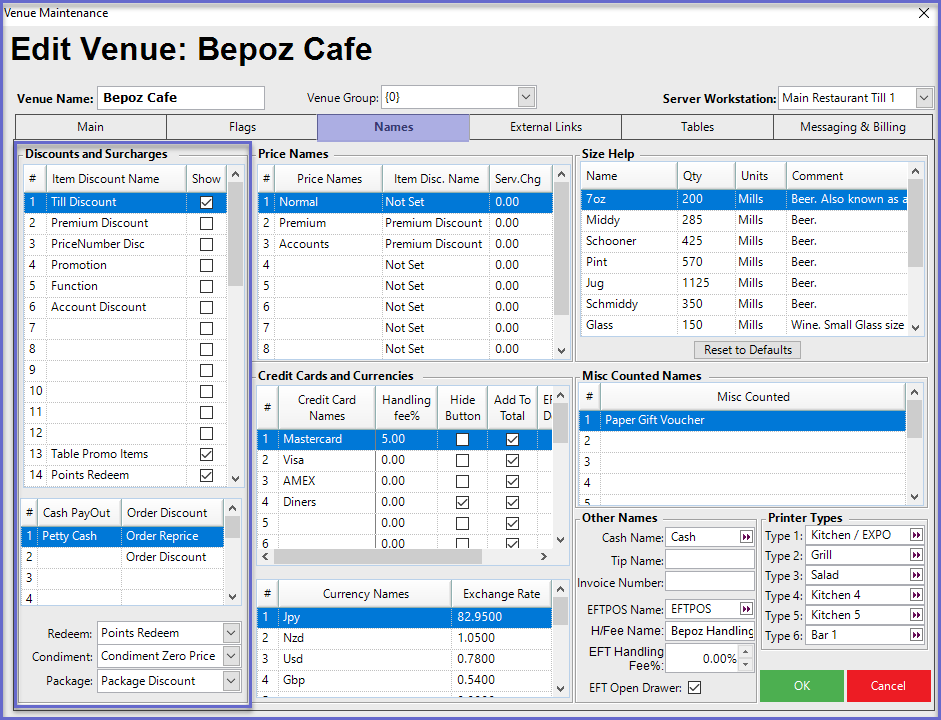
- The first Table in this section offers the capability of configuring and maintaining the Item Discount Totalizers to be used which will be assigned to Promotions , Discount Till Functions , etc. and then used for Reporting purposes
- This presents a unique feature as the Discount and Item Extra Charges applied by a Venue are quantified and added to the appropriate “Item Discount Name” for accurate Reporting
- There are thirty (30) of these totalizers and their use is meant to Report those Discounts and Extra Charges of the Venue accurately in summary form
- It's important to consider how these are used as the 30 available is typically more than required
- The # will be used in places where the Item Discount Name itself is not, such as when configuring Discount Till Functions
- The Show flag column controls whether or not the Discount or Extra Charge will be shown on the Operator and Customer screens (LCD only) as well as Printing on the Customer Receipt if required
- The second Table down follows the same concept as the first but refers to Order Discounts and Surcharges in the system which are used when a Discount or Charge is applied to an entire Transaction and not a single Item
- These will assign the Order Discounts and Points to the correct Discount Totalizer
- The rows for #s 1 through 4 cover Order Discounts that are available to Operators at SmartPOS Workstations using Order Discounts, Order Repricing, and Order Surcharges
- Order Discounts are similar to payment in that they do not apply to any specific Item but the Discount reduces - for a specific reason - the total Monetary Amount the customer is to pay
- There are ten (10) available Cash Payout names for Cash that is Paid out of the Cash Drawer of the Till
- These have a specific name in New Zealand for Gaming system Payouts but elsewhere they can be used for such things as “Petty Cash” payouts and similar usage
- These Payouts flow through to the Cash Count system so that covering Vouchers should be deposited in the Cash Drawer for reconciliation
Pre-Set Totalizers
- The three (3) drop-down fields at the bottom of this section are used as Pre-Set Totalizers respective to their names
- The options available are derived from the Item Discount Names
- The Redeem Discount Totalizer, specifically, is used for when a Product has been paid for using Bonus Points
- The Condiment Discount Totalizer, specifically, allows for Condiments that are normally charged when added as Condiments are “free” to be assigned to a Discount Totalizer so that the amount of this that is given to customers is quantified
- Likewise, the Package Discount Totalizer assigns the Discount that is applied when a Package Product is created and the Products within the Package then have reduced Pricing; the Prorated Price Discount is added to the Item Discount Totalizer
Price Names
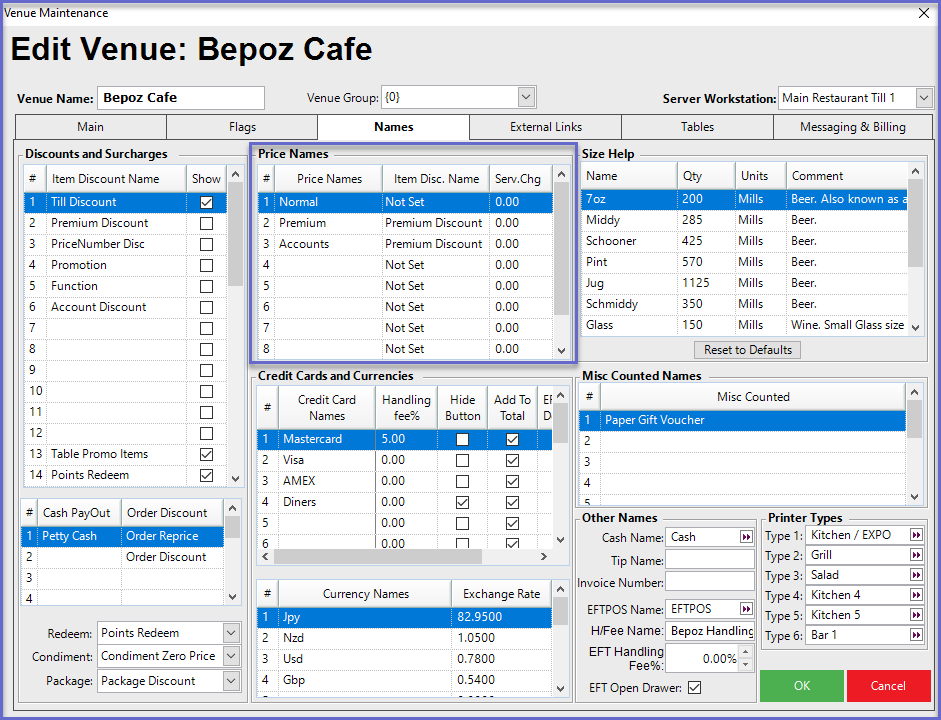
- Bepoz supports 8 Price Names which are then assigned to the 10 Size Units of a Product and for each of the Stores of a Venue
- Stores can use other Store's Price Numbers (configured via Store Maintenance ) if required, so the number of Prices available is very significant
- The Price Numbers' Names are maintained in the Price Names column and the Item Discount Name column allows for setting the Discount Totalizer that the extra income or discount accrues to for quantified Reporting
- Typically, Price Numbers are not used for such Pricing concepts as Happy Hour as this often only applies to certain restricted Products so it is best handled by Product Promotions
- Price Numbers are often used for higher Priced structures than “Normal” Pricing - such as weekend Pricing, late-night Pricing, public holiday Pricing, etc.
- The Service Charge column allows for a Service Charge percentage (%) to be added to the Price
- This is typical in some counties where Service Charges are applied but only in specific cases; e.g., dine-in as opposed to take-away
- The options for setup here allow for the aforementioned situation to be covered so that a SmartPOS Workstation selling both dine-in and takeaway will charge the correct Price for each, with the Service Charge only applying to the dine-in Products
Credit Cards and Currencies
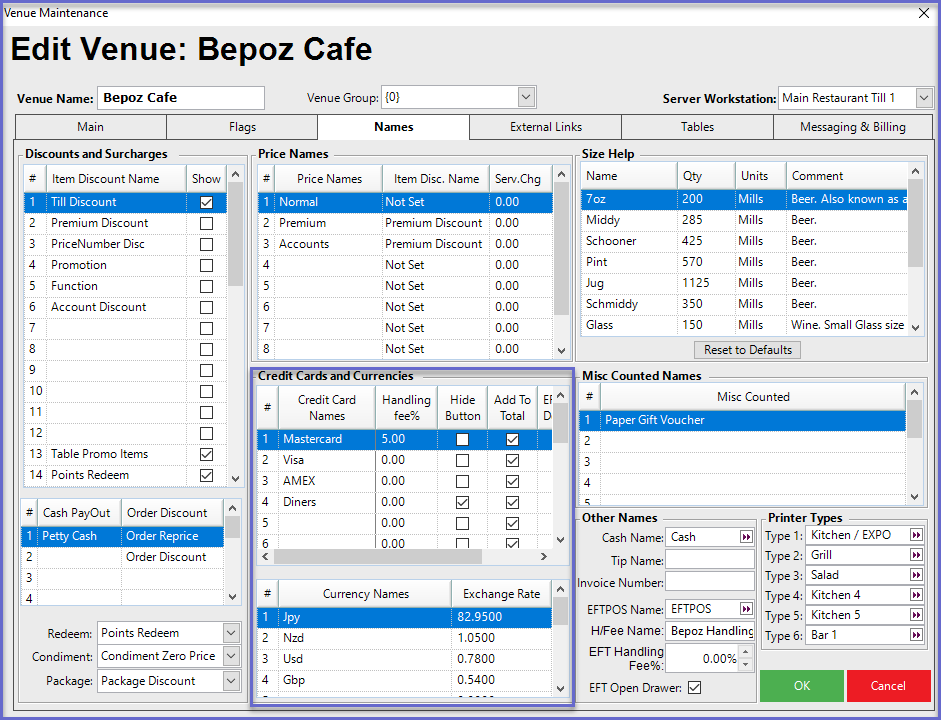
Credit Cards
- The first Table in this section allows for defining up to sixteen (16) Credit Cards by Name and also to define any Automatic Percentage to be added to a Sale by the Credit Card type as a Handling Fee
- There are columns which cannot be seen initially and you'll need to scroll to the right to access them
- The Handling Fee % column allows for separate, individual Handling Fees to be set for each Credit Card in addition to the EFT Handling Fee % (see the Other Names section for details)
- The Handling Fee % entered for each Credit Card will be added when that Credit Card's Payment button is selected by the Operator on SmartPOS Workstations; the EFT Handling Fee % will apply when the EFTPOS Button is selected
- The Hide Button flag column is used to control whether or not the Payment button for each Credit Card will appear as a default Payment Option on SmartPOS Workstations in the Venue; i.e., if a Hide Button flag is enabled for a Credit Card, no Payment button will be available in the default Payment window along with the other Payment options
- When a Handling Fee is being used for a Credit Card, do not enable the Hide Button flag for that Currency; the button needs to visible and used by the Operator to trigger the assigned Handling Fee
- If a Credit Card has a 0.00% Handling Fee (which will not trigger EFTPOS), enable the Hide Button flag for that Credit Card
- The Operator will need to use the EFTPOS button to accept that Card Type
- If there is an EFT Handling Fee%, it will be added
- The Add to Total flag will add the Eftpos payment to the total fee
- The EFT Device flag: If enabled for a card type, then when an integrated EFTPOS device is connected to SmartPOS and the credit card payment name is used, SmartPOS will trigger the integrated payment device to take payment
- If disabled, the credit card payment name will not trigger the EFTPOS device and just take payment internally as it does with a non-integrated solution
- The other Table in this section allows for up to ten (10) Foreign Currencies to be defined
- These are “foreign” currencies, not the Local currency
- The Exchange Rate can be set for each Currency and updated as required
Size Help
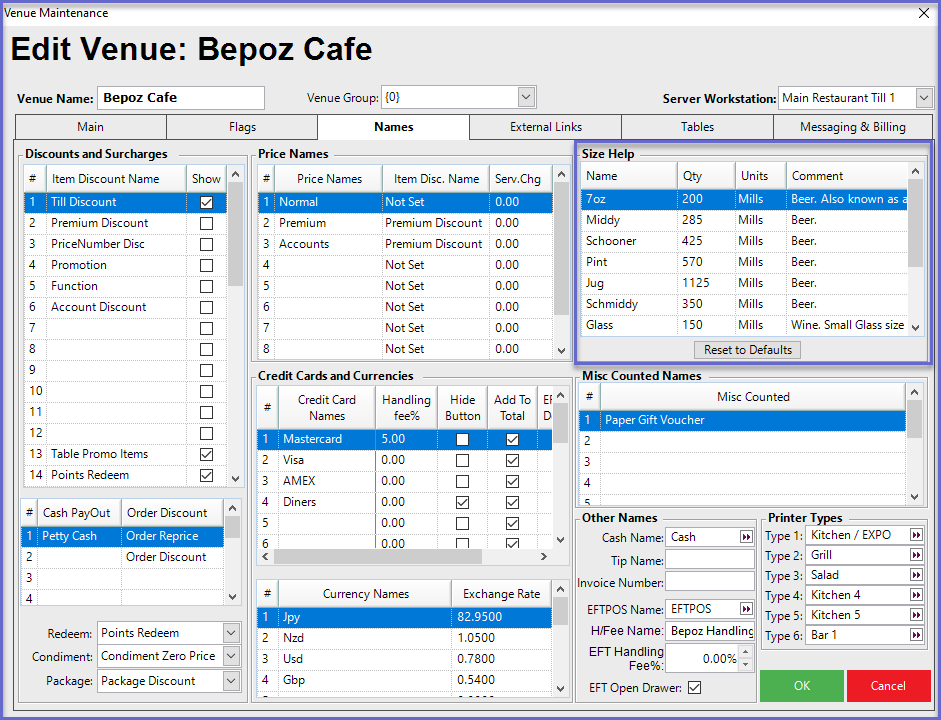
- This section is automatically populated with Regionally used Size Names and Quantities when the Regional setting is configured on the Main tab of the Venue Maintenance Record
- Selecting the Reset To Defaults button will revert the list to the Standard list for the Regional setting
- These can be changed manually to better suit the Organization's needs
- These Sizes can then be used quickly when configuring Product's Base Sizes
- By clicking on the Base Size field, a small Size Help window will pop-up allowing for selecting one of these configured Sizes and setting as the Product's Base Size
Misc Counted Names
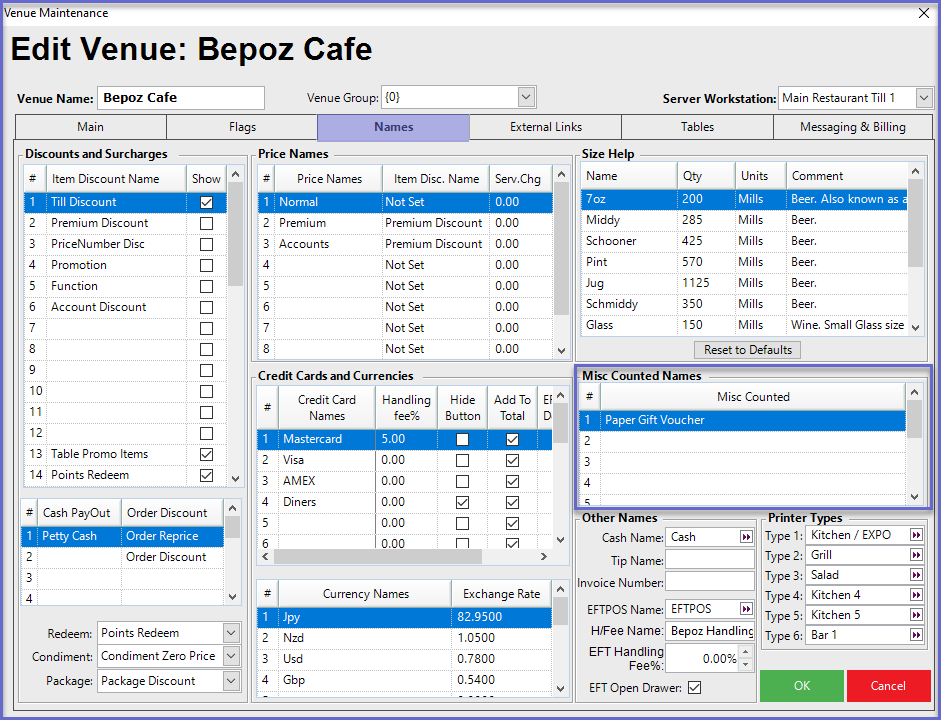
- This section is used to maintain up to eight (8) Miscellaneous Counted Names to be used in the Venue
- For example, if the Venue uses paper Gift Vouchers that aren't sold through Bepoz, a Name for them could be entered here and then the Count for them could then be Entered for the Tills in the Venue when Entering Media Counts
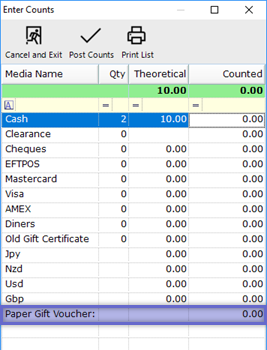
Printer Types
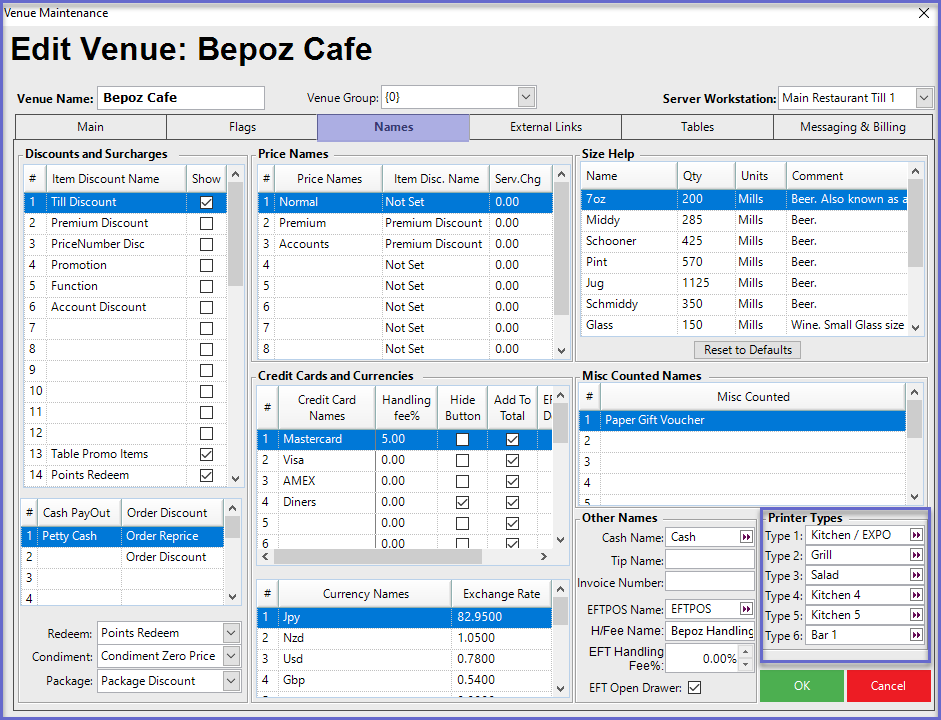
- Bepoz allows for six (6) different Remote Printer Types to be defined in this section; these are commonly used for Kitchen and/or Bar Printing
- The Type of Remote Printer can be used many times in that the Remote Printer, for example, Printing "1st Course" Items in the Main Kitchen could be a different Printer from the one Printing "1st Course" Items in the Prep Kitchen but there only needs to be one “1st Course” Remote Printer Type defined
- The Products are assigned to these Printers Types (via the Product Maintenance Printer Profile setting ) and then each Till defines which Physical Printer will Print each of these Types of tasks (via the Workstation Maintenance Printing Setup)
- Note also that Printer Profiles are maintained separately via that component of BackOffice Operational Setup
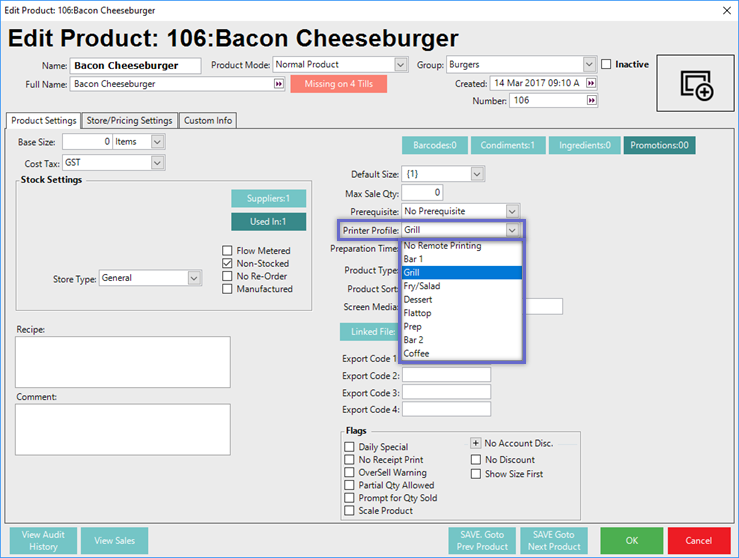
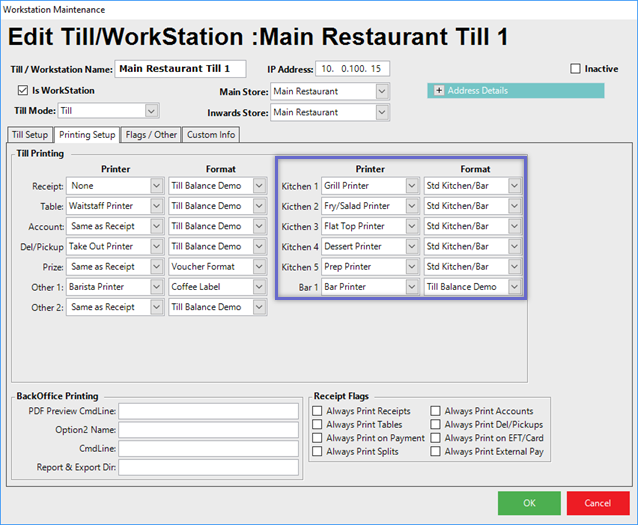
Other Names
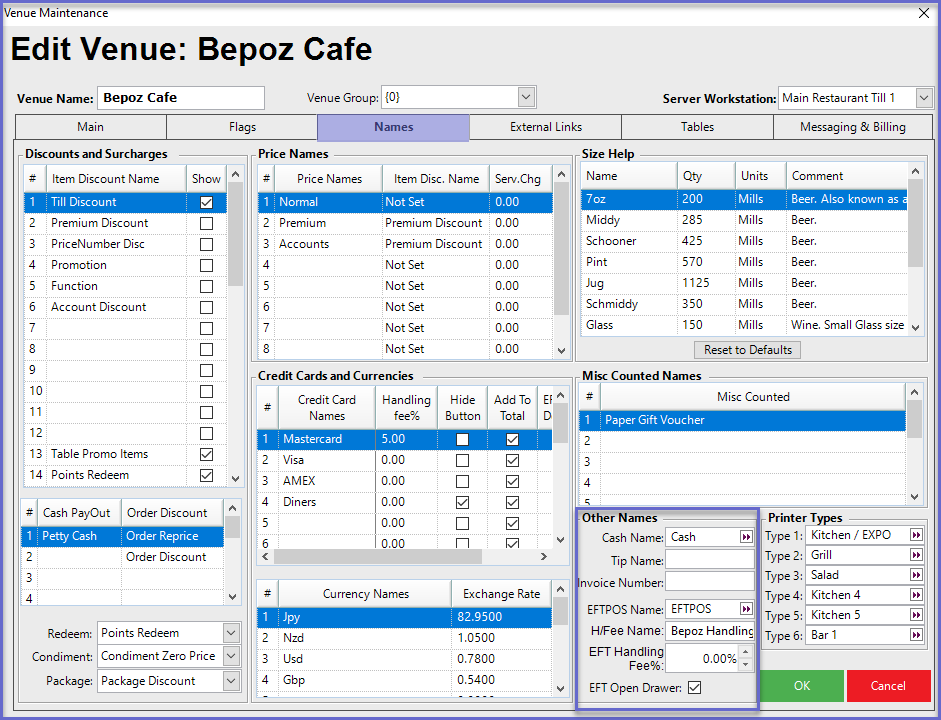
- The Other Names section is used for maintaining the Names for Cash, EFTPOS, and Service Charge and also configuring additional EFTPOS and Service Charge settings
Configuration Option |
Description |
| Cash Name |
|
| EFTPOS Name |
|
| H/Fee Name |
|
| EFT Handling Fee % |
|
| EFT Open Drawer |
|
| Invoice Number |
|
| Tip Number |
|
| Srv Charge Name |
|
| S Chg. Tax |
|
| S Chg. Auto Perc. |
|
| Serv. Chg. Min Guests |
|
